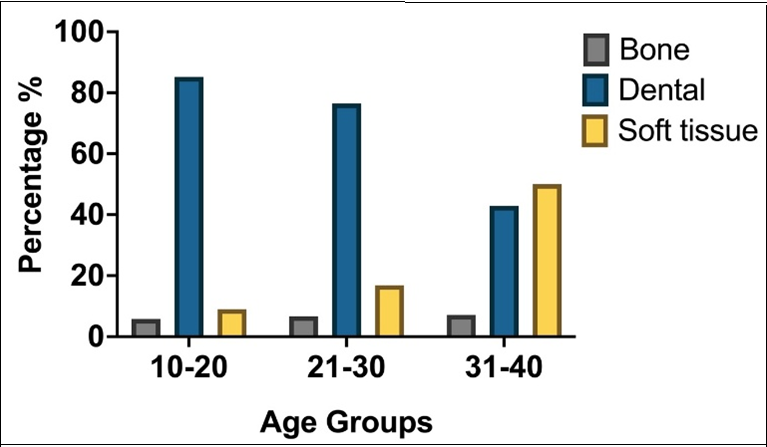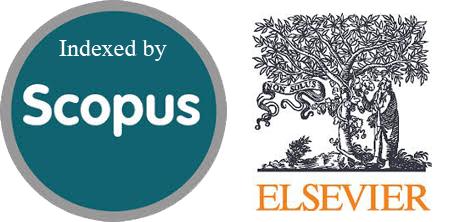Prevalence of Dental Developmental Anomalies Among Iraqi Cohorts: A Hospital-Based Cross-Sectional Study
DOI:
https://doi.org/10.54133/ajms.v9i1.2246Keywords:
Dental Anomalies, Developmental Anomalies, Iraq, Prevalence, Stomatognathic DiseasesAbstract
Background: Developmental anomalies affect oral hard and soft tissues, arising from genetic, prenatal, postnatal, environmental, and pathogenic influences. Environmental factors for dentists, updated on the epidemiology of developmental anomalies, would enhance the overall dental care provided by optimizing accurate diagnosis and personalizing the treatment. Objective: To investigate the prevalence and distribution of diverse developmental anomalies in a sample of the Iraqi population. Methods: A cross-sectional study was conducted by clinical examination of 745 systemically healthy Iraqi individuals (11-40 years) seeking dental treatment at teaching dental hospitals affiliated with Iraqi universities in Baghdad, Iraq. Results: Developmental abnormalities were found in 413(55%) of the cases, 67% of which were in males and 33% in females. Across all age groups examined, the most common developmental anomalies for both sexes were those related to the teeth. The most common dental anomaly, impaction, was found in 40% of males and 54% of females. The existence of a cusp of Carabelli (16% in males and 8% in females) was one of the other noteworthy anomalies. Anomalies relating to the bones were very rare; just 3% of males had torus mandibularis. Soft tissue anomalies were also uncommon; just 3% of females had Fordyce granules, and one male (0.4%) and one female (0.7%) had cleft lip and/or palate. Conclusions: The Iraqi population had a high prevalence of dental anomalies, among other developmental anomalies. These epidemiological findings emphasize the importance of early meticulous diagnosis of dental anomalies in patients pursuing dental treatment.
Downloads
References
Jahanimoghadam F. Dental anomalies: An update. Adv Hum Biol. 2016;6(3):112-118. doi: 10.4103/2321-8568.195316. DOI: https://doi.org/10.4103/2321-8568.195316
Akitomo T, Tsuge Y, Mitsuhata C, Nomura R. A Narrative review of the association between dental abnormalities and chemotherapy. J Clin Med. 2024;13(16):4942. doi: 10.3390/jcm13164942. DOI: https://doi.org/10.3390/jcm13164942
DeSilva M, Munoz FM, McMillan M, Kawai AT, Marshall H, Macartney KK, et al. Congenital anomalies: Case definition and guidelines for data collection, analysis, and presentation of immunization safety data. Vaccine. 2016;34(49):6015-6026. doi: 10.1016/j.vaccine.2016.03.047. DOI: https://doi.org/10.1016/j.vaccine.2016.03.047
Sella Tunis T, Sarne O, Hershkovitz I, Finkelstein T, Pavlidi AM, Shapira Y, et al. Dental anomalies' characteristics. Diagnostics (Basel, Switzerland). 2021;11(7). doi: 10.3390/diagnostics11071161. DOI: https://doi.org/10.3390/diagnostics11071161
Velez-Leon E, Guerrero E, Carrillo MO, Cabrera M, Tello G, Pinos P. The prevalence of oral anomalies among healthy newborns at a gynecological obstetric hospital in Quito, Ecuador: An observational, cross-sectional study. Dent J (Basel). 2025;13(4). doi: 10.3390/dj13040158. DOI: https://doi.org/10.3390/dj13040158
Folayan MO, (Ed.), A global compendium of oral health: Tooth eruption and hard dental tissue anomalies: Cambridge Scholars Publishing; 2019.
Anggraini L, Augustyana D, Sekarjati N. Prevalence of dental anomalies in pediatric patients at Dental and Oral Hospital of Universitas Muhammadiyah Yogyakarta. Dent J. 2023;56:63-67. doi: 10.20473/j.djmkg.v56.i1.p63-67. DOI: https://doi.org/10.20473/j.djmkg.v56.i1.p63-67
Najm AA, Mahdi AS, Al-Sudani RJ. Prevalence of dental anomalies among Iraqi dental students. J Baghdad Coll Dent. 2016;28(4):72-76. doi: 10.12816/0033214. DOI: https://doi.org/10.12816/0033214
Abd Al-Aaloosi SR, Kadhim MS, Alanbari BF. Prevalence of dental anomalies (Mesiodens and enamel hypoplasia) among primary school children in Badra/Iraq. Indian J Forensic Med Toxicol. 2020;14(1):723-728. doi: 10.37506/v14/i1/2020/ijfmt/192988.
Mohammed ARS. Distribution and prevalence of various developmental dental anomalies in Iraqi population: A radiographic Study. Mustansiriyah Dent J. 2019;14(1):137-46. doi: 10.32828/mdj.v14i1.782.
Aljuaid TSS, Manjunatha BS, Amith HV, Alshehri RA, Alharthi FB, Kariri AM. Prevalence and distribution of selected developmental dental anomalies in Taif, Saudi population. J Public Health Res. 2021;11(1). doi: 10.4081/jphr.2021.2132. DOI: https://doi.org/10.4081/jphr.2021.2132
Aljohani K, Shanab H, Alqarni A, Merdad K. Dental anomalies in Saudi Arabia: A systematic review. Healthcare (Basel). 2024;12(23). doi: 10.3390/healthcare12232323. DOI: https://doi.org/10.3390/healthcare12232323
Haba D, Decolli Y, Marciuc E, Sirghe AE. Teeth impaction and structural teeth anomalies. Semin Musculoskelet Radiol. 2020;24(5):523-534. doi: 10.1055/s-0040-1709210. DOI: https://doi.org/10.1055/s-0040-1709210
Bhavyaa R, Sujitha P, Muthu MS, Nirmal L, Patil SS. Prevalence of the Cusp of Carabelli: A systematic review and meta-analysis. Ann Hum Biol. 2021;48(7-8):572-584. doi: 10.1080/03014460.2022.2032339. DOI: https://doi.org/10.1080/03014460.2022.2032339
Mohammed SK, Fadil AG, Abdulwahab NA. (2025). Prevalence of congenitally missing of anterior teeth and premolars in selected people attending dental clinic in Basrah. Al-Rafidain J Med Sci. 2025;8(1):168–172. doi: 10.54133/ajms.v8i1.1671. DOI: https://doi.org/10.54133/ajms.v8i1.1671
Simunković SK, Bozić M, Alajbeg IZ, Dulcić N, Boras VV. Prevalence of torus palatinus and torus mandibularis in the Split-Dalmatian County, Croatia. Coll Antropol. 2011;35(3):637-641. PMID: 22053535.
Nouri MA, Hamad SA, Rasheed NE. Incidence of cleft lip and palate in Erbil City. Mustansiriyah Dent J. 2018;7(1):106-112. doi: 10.32828/mdj.v7i1.383. DOI: https://doi.org/10.32828/mdj.v7i1.383
Mahmood SD, Al-Mulla AA. Incidence of cleft lip and palate in Al-Ramadi city: Descriptive epidemiological study. J Bagh Coll Dent. 2016;28(2):139-144. doi: 10.12816/0028237. DOI: https://doi.org/10.12816/0028237

Downloads
Published
How to Cite
Issue
Section
License
Copyright (c) 2025 Al-Rafidain Journal of Medical Sciences ( ISSN 2789-3219 )

This work is licensed under a Creative Commons Attribution-NonCommercial-ShareAlike 4.0 International License.
Published by Al-Rafidain University College. This is an open access journal issued under the CC BY-NC-SA 4.0 license (https://creativecommons.org/licenses/by-nc-sa/4.0/).











